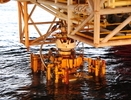
BP Inquiry Says Multiple Failures Caused Explosion
One of the eight "key findings" is the first action to control the well, routing the rising oil and gas to the mud gas separator system aboard the Deepwater Horizon platform. If they had been routed overboard instead, the accident might have been less severe, the investigative panel concluded.
BP issued its Deepwater Horizon Accident Investigation Report today, emphasizing that no single failure caused the April 20 explosion on the Deepwater Horizon drilling platform and the subsequent massive oil spill in the Gulf of Mexico. Outgoing BP CEO Tony Hayward commissioned the internal investigation and said fault lies both with BP and some of its partners in the Macondo well.
"The investigation report provides critical new information on the causes of this terrible accident," Hayward said in a news release. "It is evident that a series of complex events, rather than a single mistake or failure, led to the tragedy. Multiple parties, including BP, Halliburton, and Transocean, were involved. To put it simply, there was a bad cement job and a failure of the shoe track barrier at the bottom of the well, which let hydrocarbons from the reservoir into the production casing. The negative pressure test was accepted when it should not have been; there were failures in well control procedures and in the blowout preventer; and the rig's fire and gas system did not prevent ignition.
"Based on the report, it would appear unlikely that the well design contributed to the incident, as the investigation found that the hydrocarbons flowed up the production casing through the bottom of the well," Hayward added. The man who is replacing Hayward as chief executive, Bob Dudley, said, "We have said from the beginning that the explosion on the Deepwater Horizon was a shared responsibility among many entities. This report makes that conclusion even clearer, presenting a detailed analysis of the facts and recommendations for improvement both for BP and the other parties involved. We have accepted all the recommendations and are examining how best to implement them across our drilling operations worldwide."
Eleven workers died in the explosion. Cleanup operations in the gulf region continue, although the spill was halted weeks ago. All of the containment boom, measuring more than 1.6 million feet, has been removed from Mississippi, Alabama, and the Florida Panhandle, the unified command overseeing the spill announced Sept. 7. Also, the federal Bureau of Ocean Energy Management, Regulation and Enforcement completed its sixth public meeting to discuss the deepwater drilling moratorium, drilling safety reforms, oil spill response, and other issues with industry stakeholders.
BP said its report is based on a four-month investigation headed by Mark Bly, BP's Safety and Operations leader, and conducted independently by a team of some 50 specialists within and outside BP. "This was a tragic accident that resulted in the loss of 11 lives and impacted the communities and the environment along the Gulf Coast region. We deeply regret this event," Hayward said. "We have sought throughout to step up to our responsibilities. We are determined to learn the lessons for the future, and we will be undertaking a broad-scale review to further improve the safety of our operations. We will invest whatever it takes to achieve that. It will be incumbent on everyone at BP to embrace and implement the changes necessary to ensure that a tragedy like this can never happen again."
Transocean Ltd. owned the drilling platform. Last month, the company reported it had recorded $82 million of expenses in the second quarter related to the accident and a $267 million gain after tax from insurance recoveries associated with the loss of the Deepwater Horizon.